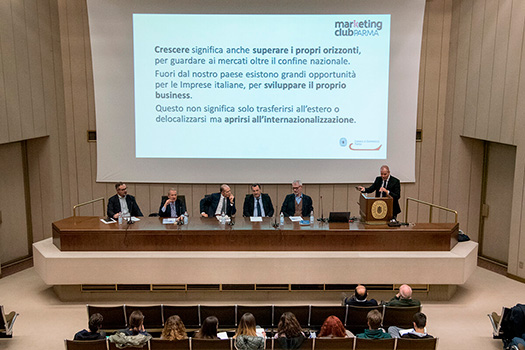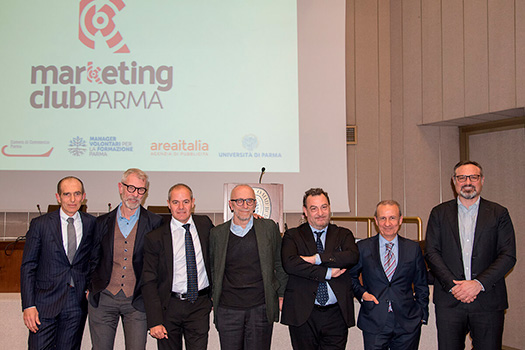Best practices for internationalization. Round table discussion with Luca Gazocchi
On the 5th of April, the Parma Marketing Club and the Chamber of Commerce invited BKey Consulting president Luca Gazocchi to attend a round table discussion about managing the internationalization of companies.
Also present at the event were Eugenio Maini, friend and ex senior partner of BKey Consulting, Massimiliano Palumbo, business development director of Schlegel Giesse, Fabio Colliva, general director of Barilla Mexico, Fratelli Branca Argentina and Vicenzi Spa. Marketing Blu partner Renzo Rizzo acted as moderator.
The Parma Marketing Club was founded in 1989 by professor Carlo Carli, who at the time taught at the University of Parma’s Economics and Business department and also founded the Marketing Council and Laboratory. Today his legacy lives on through Carlos Salicrù Gairalt, current president of the Parma Marketing Club and BKey Consulting senior consultant, who is joined by other volunteers who invest their passion and expertise in managing the club’s activities.
During the 5th of April’s round table the speakers talked about the best practices businesses should take into account when expanding abroad.
Choosing the right market
The choice of foreign market cannot be made randomly, or by intuition alone. The choice should be based on an analysis of macroeconomic indicators, infrastructure, competitors and market size. A good strategy should consider approaching the market via exportation, avoiding the establishment of a new business branch at the onset.
The distributor: a key to accessing the market
The best way to start is to cooperate with a trustworthy and specialized distributor with already rooted in the territory and with a firm knowledge of the end client. It’s also important to avoid possible conflicts of interest by looking for a complementary partner in order to maximize the synergies. It is also essential to keep the cooperation agreements under control through well-designed contracts in order to avoid losing touch with the end consumer.
The Joint Venture: a commercial wedding
A Joint Venture is an alternative that allows a company to enter a new market by sharing the entrepreneurial risk with a local expert. Therefore, the choice of partner is similar to undertaking a commercial marriage: you must be sure to share common values, business methods and ideas concerning the project’s strategic value for both parties. Even then, it is essential that there be no conflicts of interest.
The active design of the value chain
A clear knowledge of distribution channels and their economic framework is essential for success. In case of consumer products, the dynamics tend to be quite similar thanks to the common evolution of the global large-scale retail market. For other industries the dynamics rely on middlemen such as dealers and wholesalers, which absorb a big portion of the profit margin. Another complex element that could become an opportunity is the e-commerce market, which inevitably creates an international trade network. In this case, it is necessary to avoid uneven pricing policies. Whichever the framework is, it is essential to design the value chain starting from the definition of the final selling price and not to passively experience it.
Product communication
The definition and placement of the product represent one of the big marketing challenges, even more so when entering a new market. Often, if the company succeeds in its native country, it could take the expansion for granted. On the contrary, it is necessary to communicate the value and uniqueness of the offer in order to become the consumers’ choice.
The challenges of a local branch: culture, people and roles.
While a representative office could be necessary from the beginning, a business branch should be opened only following a rational economic study. In fact, establishing a new branch is an onerous financial effort and it entails numerous challenges such as:
• hiring, which should integrate both trusted personnel from headquarters and local workers;
• division of roles between the headquarters and the branch office. It is advisable that local employees be given autonomy, as they understand the market best, while staff from headquarters can help to ensure brand coherence.
• cultural differences, which account for a different way of doing things. This can be overcome by adopting shared processes and values to create a common outlook decision process.
In conclusion, internationalization is essential for the growth of most businesses. However, this process must be planned strategically in such a way as to create a shared style of management between headquarters and the branch offices as pertains to business processes, brand positioning, managing the value chain and the uniqueness and differentiation of the offer.
Go Back









